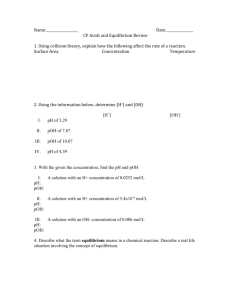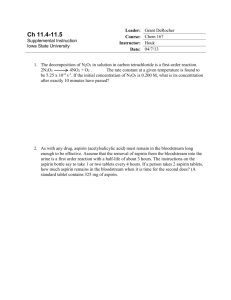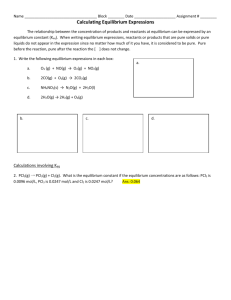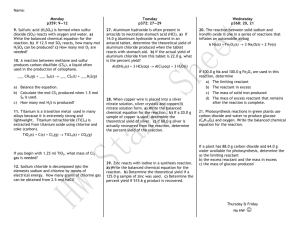practice exam # 2
advertisement
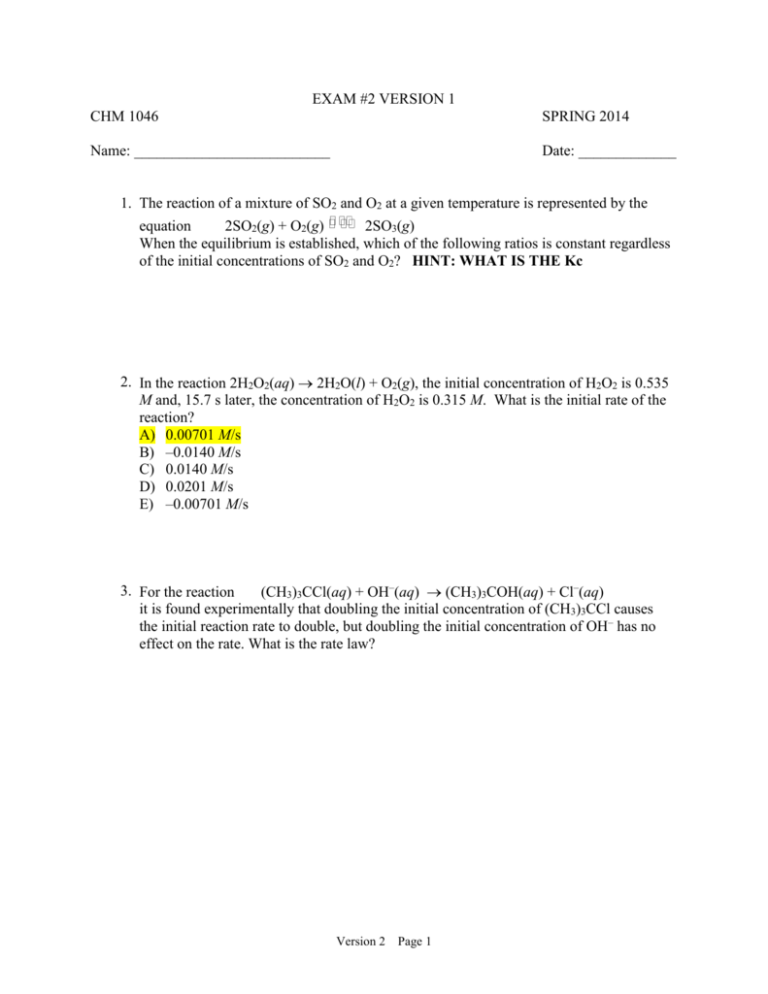
EXAM #2 VERSION 1 CHM 1046 SPRING 2014 Name: __________________________ Date: _____________ 1. The reaction of a mixture of SO2 and O2 at a given temperature is represented by the equation 2SO2(g) + O2(g) 2SO3(g) When the equilibrium is established, which of the following ratios is constant regardless of the initial concentrations of SO2 and O2? HINT: WHAT IS THE Kc 2. In the reaction 2H2O2(aq) 2H2O(l) + O2(g), the initial concentration of H2O2 is 0.535 M and, 15.7 s later, the concentration of H2O2 is 0.315 M. What is the initial rate of the reaction? A) 0.00701 M/s B) –0.0140 M/s C) 0.0140 M/s D) 0.0201 M/s E) –0.00701 M/s 3. For the reaction (CH3)3CCl(aq) + OH–(aq) (CH3)3COH(aq) + Cl–(aq) it is found experimentally that doubling the initial concentration of (CH3)3CCl causes the initial reaction rate to double, but doubling the initial concentration of OH– has no effect on the rate. What is the rate law? Version 2 Page 1 4. The half-life of a reaction is A) the time it takes for the reactant concentration to decrease to one-half of its initial value. B) the time it takes for the amount of product formed to equal half the initial amount of reactant. C) twice as long for a second-order reaction as it is for a first-order reaction. D) how long the reaction can run before stopping. E) one-half of the time the reaction will take to go to completion. 6. Ammonia is prepared industrially by the reaction N2(g) + 3H2(g) 2NH3(g) For the reaction, H° = –92.2 kJ and K (at 25°C) = 4.0 × 108. When the temperature of the reaction is increased to 500°C, which of the following statements is true? A) The reaction of N2 with H2 to form ammonia is endothermic. B) Product formation (at equilibrium) is not favored as the temperature is raised. C) K for the reaction will be larger at 500°C than at 25°C. D) At equilibrium, more NH3 is present at 500°C than at 25°C. E) None of the above statements is true. 7. A chemical reaction that is first-order in X is observed to have a rate constant of 1.5 × 10-2s-1. If the initial concentration of X is 1.0 M, what is the concentration of X after 205 s? A) 0.25 M B) 22 M C) 0.95 M D) 0.046 M E) 0.69 M 8. One method for the decomposition of carbon dioxide proceeds as follows: 2CO2(g) 2CO(g) + O2(g); H= 559 kJ Which of the following changes will cause an increase in the equilibrium concentration of CO? A) increasing the temperature of the system B) removing CO2 from the system C) adding a catalyst D) adding more O2 to the system E) increasing the pressure of the system at constant temperature Version 2 Page 2 9. Consider the following reaction: 2HF(g ) H 2 (g ) + F2 (g ) (Kc = 1.00 10-2) Given that 1.00 mol of HF(g), 0.389 mol of H2(g), and 0.750 mol of F2(g) are mixed in a 5.00-L flask, determine the reaction quotient, Q. A) Q = 2.14 B) Q = 0.0729 C) Q = 0.0584 D) Q = 0.292 E) none of these 10. The rate constants for the first-order decomposition of a compound are 4.83 × 10–4 s-1 at 42°C and 2.97 × 10–3 s-1 at 65°C. What is the value of the activation energy for this reaction? (R = 8.31 J/(mol · K)) A) 0.778 kJ/mol B) 30.3 kJ/mol C) 0.656 kJ/mol D) 69.9 kJ/mol E) 1.79 kJ/mol 11. Which of the following is true for a system whose equilibrium constant is relatively small? A) The equilibrium lies to the right. B) The equilibrium lies to the left. C) It will take a short time to reach equilibrium. D) It will take a long time to reach equilibrium. E) Two of these are true. 12. For the reaction 2N2O5(g) 4NO2(g) + O2(g) write the rate expression that is equal to the rate of the reaction? Version 2 Page 3 13. If a reaction is zero-order in a reactant, when the concentration of the reactant is decreased by a factor of 2, the reaction rate will A) decrease by a factor of 1/4. B) decrease by a factor of 1/2. C) double. D) quadruple. E) remain constant. 14. Nitrosyl chloride is produced from the reaction of nitrogen monoxide and chlorine: 2NO(g) + Cl2(g) 2NOCl(g) The following initial rates at a given temperature were obtained for the concentrations listed below. Experiment Initial Rate (mol·L-1·h -1) [ NO]0 (mol·L-1) [Cl2]0 (mol·L-1) 1 2.21 0.25 0.25 2 8.84 0.50 0.25 3 4.42 0.25 0.50 From the data, what is the experimental rate law? Calculate the rate constant. 15. Consider the following system at equilibrium: N2(g) + 3H2(g) 2NH3(g) H= - 92.94 kJ Which of the following changes will shift the equilibrium to the right? CIRCLE ALL CORRECT CHOICES I. increasing the temperature II. decreasing the temperature III. increasing the volume IV. decreasing the volume V. removing some NH3 VI. adding some NH3 VII. removing some N2 VIII adding some N2 Version 2 Page 4 16. A reaction that is second-order in one reactant has a rate constant of 2.0 × 10-2 L/(mol · s). If the initial concentration of the reactant is 0.220 mol/L, how long will it take for the concentration to become 0.110 mol/L? A) 114 s B) 2300 s C) 35 s D) 350 s E) 230 s 17. At a given temperature, a first-order reaction has a rate constant of 2.0 × 10-3 s-1. How long will it take for the reaction to be 29% complete? A) 1700 s B) 2100 s C) 620 s D) 74 s E) 170 s 18. For which of the following equilibria does Kc = Kp? A) HBr(g) ½H2(g) + ½Br2(l) B) N2(g) + 3H2(g) C) CaO(s) + CO2(g) D) CO(g) + H2O(g) E) CO(g) + 3H2(g) 2NH3(g) CaCO3(s) CO2(g) + H2(g) CH4(g) + H2O(g) 19. The reaction quotient for a system is 7.2 × 102. If the equilibrium constant for the system is 36, what will happen as equilibrium is approached? A) There will be a net gain in reactant. B) There will be no net gain in either product or reactant. C) The equilibrium constant will decrease until it equals the reaction quotient. D) There will be a net gain in both product and reactant. E) There will be a net gain in product. Version 2 Page 5 20. Nitrogen trifluoride decomposes to form nitrogen and fluorine gases according to the following equation: 2NF3(g) N2(g) + 3F2(g) When 2.04 mol of NF3 is placed in a 2.50-L container and allowed to come to equilibrium at 800 K, the mixture is found to contain 0.0252 mol of N2. What is the value of Kp at this temperature? 21. Consider the following equilibrium: 2NO(g) + 3F2(g) 2NOF3(g) Suppose 0.20 mol of NO and 0.30 mol of F2 are added to a 5.0-L container. If x mol of NOF3 is present at equilibrium, how many moles of fluorine are present at equilibrium? A) 0.30 – x B) 0.20 – x 3 C) 0.30 – 2 x D) 0.30 – 2x E) 0.06 – 0.20x Version 2 Page 6 22. Thyroxine, an important hormone that controls the rate of metabolism in the body, can be isolated from the thyroid gland. If 0.453 g of thyroxine is dissolved in 10.0 g of benzene, the freezing point of the solution could be measured as 5.144°C. Pure benzene freezes at 5.444°C and has a value for the molal freezing-point-depression constant of Kf of 5.12°C/m. What is the approximate molar mass of thyroxine? 23. Calculate the molecular weight of a small protein if a 0.29-g sample dissolved in 160 mL of water has an osmotic pressure of 9.3 mmHg at 23°C. (R = 0.0821 L · atm/(K · mol)) 24. What is the vapor pressure at 75°C of an aqueous solution prepared by the addition of 72.4 g of urea, CO(NH2)2, to 205 g of water? The vapor pressure of pure water at 75°C is 303mmHg. 25. List the different intermolecular forces that can exist in solutions and give examples: Version 2 Page 7 Version 2 Page 8 Version 2 Page 9 Clausius-Clapeyron Equation ln P2 = Hvap * 1 - 1 P1 R T1 T2 Solubility S2 = P2 S1 P1 Raoult’s Law Psoln = Psolv · Xsolv Psoln = PsolnO - P Arrhenius Equation ln k2 = Ea * 1 - 1 k1 R T1 T2 Freezing Point Depression Tf = kfCm Boiling Point Elevation Tb= kbCm Osmotic Pressure = MRT Kp = Kc[RT]n Order Rate Expression Conc-Time Relation Half-life Linear Plot 0 Rate = k [A] – [A] = kt [A] [A] vs. t 0 0 2k 1 Rate = k[A] ln [A] = kt 0 [A] 2 2 Rate = k[A] 1 – 1 = kt [A] [A] 0 Version 2 Page 10 0.693 k ln [A] vs. t 1 k[A] 1 vs. t [A] 0


